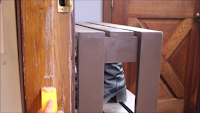Stuck in your house because of self isolation, watched all your can on the TV and internet, now the boredom sets in! Here is a few ideas you can do to keep you busy and inside while we wait for the world to turn back on. All these projects I've done with non-toxic removal products by Max Strip. It's the only brand I would recommend for tough inside removal jobs. If you want to see more info on these products and more visit https://maxstrip.com/
Removing Stickers

I had this garage sales find mirror covered in stickers I've been meaning to clean up and use as a decoration in my mud room for a while. I used a non-toxic all purpose remover called Max Strip All Purpose Remover so I could do it right in my living room! It was easy just sprayed on and let sit for about 15 minutes. Then scraped them off and wiped clean with water.
It works great on all kinds of tough and sticky removal jobs I've completed so many projects that I had been meaning to do forever. Like clean my oven, the BBQ, oil spills on concrete, remove permanent marker, and a lot more. See detailed how to remove info on projects here.
Tape Residue Removal
The next project I wanted to share is one I did with a non-toxic paint and varnish stripper from Max Strip. I love a great garage sale find and you would be surprised at what you can find under all the wow that was an interesting color choice for your furniture finds!
I had planned to refinish this chest in warmer weather until I tried Max Strip Paint & Varnish Stripper you can safely use it inside, it's environmentally friendly, and cleans up with just water! Max Strip made this refinish project way easier than I thought it was going to be. This one I let sit for about an hour because I wasn't sure what kind of paint was on there or how old it was. I just knew there was a beautiful old chest under there and for $10 bucks and an hour of my time it was totally worth it.
I have done this to an old table, another mirror with a wood frame I found at the dump, my desk, my stairs and some more things around the house. See detailed how to remove info on projects here.
Wall Washing


This one is really great because you get the power of a magic eraser in a spray bottle! Max Strip Project Prep is great for prepping surfaces for painting or refinishing but you can also just use it to brighten all kinds of hard surfaces with an easy clean. Just spray and wipe clean with water. For really dirty or stubborn marks let it sit for a few minutes before wiping.
The prep to paint this room was so easy to do with Max Strip! See detailed how to remove info on projects here.







